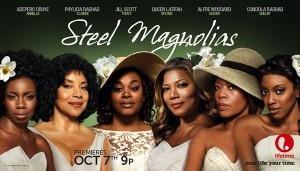I knew we would be served Steel Magnolias in blackface, but I didn’t care. The idea of representations of black (southern) women on television was enough reason to tune in to Lifetime’s star-studded remake of the classic southern white women’s tear factory. With Alfre Woodard, Phylicia Rashad, Jill Scott, Queen Latifah, and Adepero Oduye leading, if the whole thing went to hell, at least the ladies would shepherd it in a badass actress basket. Right?
Ahem. Newwwoooh.
While I am generally forgiving of terrible southern accents—I know y’all can’t talk like us—I was struck by Jill Scott’s imitation of a white southern woman’s accent to play a black southern woman. Jilly from Philly, who once sang, “fatback taffy sho’ is good to me/fatback taffy knocks me off my feet,” turned into Paula Deen. Jill’s Tropic Thunder whitetalk-blacktalk-whitetalk accent, though, is symptomatic of a broader issue: our continued inability to imagine black women as southern and/or middle class beyond church hats and fans.
Further, save for the wobbling at the wedding reception (which has become popular even at white folks’ nuptial celebrations) the unaltered script with black faces produced a bizarro-world in which a group of black women could meet in a beauty shop week after week and never talk about race or black womanhood. In attempting to imagine black women as southerners, region obliterated race, offering that same old color-blind racist yoke that produces empathic blacks by, well, erasing their blackness. The most promising moments in the film were those where blackness threatened to interrupt and intersect with the narrative. In the iconic scene where M’Lynn, played by Queen Latifah, finally lets her emotions loose in the shop, I saw glimpses of Set It Off’s Cleo, and half-hoped the ladies would all ride out and rob a bank. Talk about wheelz of steel.
Perhaps what’s most frustrating about Negresses of Steel is that black women’s femininity—or specifically their (perceived, constructed) lack thereof—makes possible the varied archetypes of white southern womanhood, from sundress-wearing belles to infallible magnolias. White southern womanhood in particular is predicated on black southern womanhood, not the other way around, which is what a blackface Steel Magnolias gets us. We still know painfully little about black southern womanhood, and even less about the contemporary black southern womanhood Steel Magnolias attempts to offer us. For all of their supposed ratchetness, Real Housewives of Atlanta, Love and Hip-Hop Atlanta, and Tyler Perry’s corpus give us that glimpse into an originary black womanhood for which we are all guilty of seeking out. Sometimes Zora and Ida B. ain’t enough to make it through the week.
I recognize that we really can’t talk about black women as a differentiated group such that the notion of wanting a particular group of black women—in this case, southern black women—to be represented with any nuance is absurd. However, that there are regional variations in black women’s experiences is undeniable, from incarceration to marriage to infant mortality rates. The cyclical nature of black migration notwithstanding, there are key cultural differences, too, that deserve attention, beyond church hats, diabetes-sweet tea, and backyard collard greens. Because (and in spite) of the film’s shortcomings and what those failures highlight about the invisibility of black women writ large, Negresses of Steel compels us to imagine (because they ain’t there) the intersections of race, class, gender, and region in black southern women’s lives and to endeavor to make the perspectives of actual black women central to the multitude of discourses about black women.
